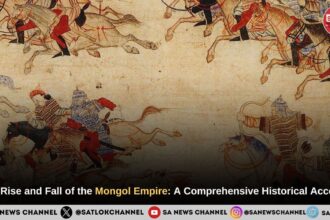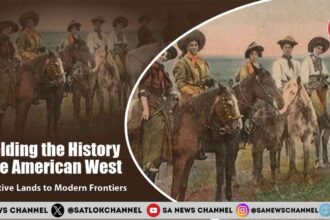Imagine the sound of clashing swords, the thunder of horses galloping across a battlefield, and the gleam of shining armor under the sun. For centuries, this image has defined the world of medieval knights. They were often portrayed as gallant warriors, loyal defenders of kings, and protectors of the weak.
- Who Were the Medieval Knights?
- History and Origins (9th–12th Century)
- Lifestyle and Training
- Warfare and Battle Tactics
- Knights and Society
- Myths vs. Reality
- Legacy and Modern Influence
- Spiritual Perspective: Lessons from Knights and the Prince Who Found God
- FAQs about the history of the Medieval Knights
- 1. What was the main role of medieval knights?
- 2. How did someone become a knight in the Middle Ages?
- 3. What values were included in the Code of Chivalry?
- 4. Were all knights truly noble and spiritual?
- 5. How do knights influence the modern world today?
- Connect With Us on the Following Social Media Platforms
But who were these knights in reality? Were they truly as noble as legends suggest, or was their life far more complex and challenging? This article explores the real history of the medieval knights, their origins, training, roles in warfare and society, myths versus reality, and how their legacy still shapes modern culture.
Who Were the Medieval Knights?
A medieval knight was not just a soldier on horseback but a figure deeply rooted in the feudal system of Europe. Knights were warriors bound to serve their lords and kings in exchange for land, wealth, or privileges. They swore loyalty, followed a code of honor called chivalry, and were expected to defend both their realm and faith. However, their role extended beyond war, they were social symbols of status and power, representing the fusion of military strength with noble prestige.
History and Origins (9th–12th Century)
The rise of knights began in early medieval Europe, particularly around the 9th century, when frequent invasions from Vikings, Magyars, and Saracens made effective cavalry crucial. Mounted warriors proved faster and deadlier than foot soldiers, giving rulers a reason to reward them with land and titles.
By the 11th and 12th centuries, the knight had become a central part of the feudal hierarchy. Kings granted fiefs (land) to nobles, who in turn trained knights to serve as their military backbone. The church also played a role, blessing knights as defenders of Christianity, especially during the Crusades. The image of the knight as both warrior and holy soldier took root during this time, blending religious duty with martial valor.
Lifestyle and Training
The path to knighthood was long and disciplined. A boy of noble birth would begin as a page around the age of 7, learning basic etiquette, horsemanship, and sword handling. By his teens, he became a squire, serving a senior knight, polishing armor, caring for horses, and gaining combat training. Only after years of dedication and a ceremonial “dubbing” by a lord or king could he become a full-fledged knight.

Knights followed the Code of Chivalry, which emphasized loyalty, bravery, courtesy, and the protection of women and the weak. Their weapons included swords, lances, and shields, while armor evolved from chainmail to heavy plate armor. Despite the glamour of tournaments and jousts, daily life was not always glorious, training was harsh, armor was heavy, and warfare was brutal. Knights also had to manage lands or estates given to them, blending military and administrative duties.
Warfare and Battle Tactics
Knights were primarily cavalry warriors, and their shock power in battle was legendary. A charge of armored knights on horseback could crush enemy lines. Famous tactics included using long lances for initial impact followed by close combat with swords.
Over time, however, new weapons such as the longbow and crossbow reduced their dominance. The Battle of Agincourt (1415) showed how heavily armored knights could be defeated by disciplined archers. Siege warfare also grew in importance, where knights played roles in defending or attacking castles. Despite these challenges, knights remained symbols of military prestige until the late Middle Ages, when professional armies and gunpowder weapons changed warfare forever.
Knights and Society
Knights were not just fighters; they were also influential in society. They held land, collected taxes, and enforced their lord’s authority. Through the Crusades, knights became associated with defending Christianity, though in practice these campaigns were often politically and economically motivated.
Also Read: The Spanish Civil War Explained: From Causes to Consequences
Women admired knights in courtly traditions, where poets celebrated “courtly love.” Yet, real-life relationships were more complex, many knights prioritized power and wealth over romance. Their presence shaped medieval culture, art, and social values, creating a lasting image of knighthood as both noble and heroic.
Myths vs. Reality
Legends such as King Arthur and the Knights of the Round Table portray knights as flawless heroes. In reality, knights were human, sometimes noble, sometimes ruthless. While some upheld the chivalric code, others exploited peasants, looted lands, or fought for personal gain. The romanticized knight of poetry often differed greatly from the ambitious warrior who lived by the sword.
Legacy and Modern Influence
Though knights declined by the late 15th century, their legacy endures. Modern concepts of honor, military decoration, and even fictional superheroes draw from chivalric ideals. The word “knight” itself survives in ceremonial orders like the Knights of the Garter in England. Their history continues to inspire novels, films, and games, keeping the fascination with armored warriors alive.
Spiritual Perspective: Lessons from Knights and the Prince Who Found God
The life of medieval knights reminds us of both courage and vanity. They fought countless battles, shedding blood in the name of power, land, or religion, yet none of these pursuits brought them eternal peace. Tatvdarshi Sant Rampal Ji Maharaj explains that human life is not meant for violence or conquest, but for realizing the Supreme God Kabir Saheb Ji and performing true devotion.
Just as knights spent years training their bodies and minds for war, seekers should discipline their lives for spiritual progress. True chivalry lies not in conquering kingdoms but in conquering one’s vices; anger, greed, and ego. Worldly glory fades, but spiritual truth leads to liberation (moksha). Through the path of true devotion, revealed by a Tatvdarshi Saint, one can achieve what no knight ever won: eternal freedom in Satlok, the everlasting abode of God.
This lesson is beautifully illustrated in the inspiring story of a prince Mansur Ali of Baghdad who surrendered his entire life after realizing the Supreme God. Even a life of royalty, wealth, and power could not give him the inner peace that devotion offers. As Sant Rampal Ji Maharaj teaches, worldly status is temporary, but surrendering to the Supreme God transforms life into one of humility, spiritual awakening, and eternal liberation.
FAQs about the history of the Medieval Knights
1. What was the main role of medieval knights?
Medieval knights served as mounted warriors under the feudal system. They defended their lords’ lands, participated in battles, and upheld the chivalric code, though not all lived up to it.
2. How did someone become a knight in the Middle Ages?
A boy started as a page, then a squire, and after years of training and service, he could be knighted by a lord or king through a formal ceremony.
3. What values were included in the Code of Chivalry?
The code emphasized loyalty, courage, faith, courtesy, and protection of the weak, though in practice many knights failed to fully embody these ideals.
4. Were all knights truly noble and spiritual?
Not necessarily. While some knights were honorable, many pursued wealth and power. Their actions often contradicted the ideals of chivalry celebrated in literature.
5. How do knights influence the modern world today?
Knights inspire modern ideas of honor, courage, and ceremonial titles. Literature, films, and cultural traditions continue to celebrate their image, blending myth and history.









